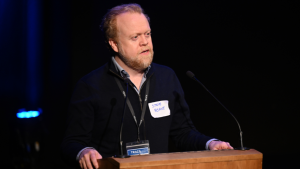Though the morning was frosty, there was a distinct warmth in Perth Theatre on Friday 14 November as artists, community tradition-bearers, academics and cultural leaders came together, both in person and online, for the third annual Intangible Cultural Heritage (ICH) Conference. Organised and funded by the ICH Scotland Partnership – Creative Scotland, TRACS (Traditional Arts and Culture Scotland), Historic Environment Scotland and Museum Galleries Scotland – and supported by Perth & Kinross Council with endorsement from Perth UNESCO City of Craft and Folk Art, the conference focussed on the theme Moving Forward with Living Heritage.

On the eve of Scotland launching the process for developing its own national inventory of Living Heritage practices, the first step in a UK-wide process led by the Department of Culture Media and Sport, communities showed a growing interest in gaining recognition, understanding their traditions, and exploring what sustained practice looks like. The day’s programme reflected that shift from policy toward practice: there was a busy, purposeful buzz in the theatre as practitioners, curators, policymakers and community representatives exchanged experience and explored next steps.

Speakers and contributors included Poppy Jarrat, UNESCO Programme Officer Perth, musician and broadcaster Gary West, and presentations from master kilt-maker Marion Foster, traditional dance specialist Pat Ballantyne, Scots singer and artist Quinie, and storyteller and Traveller Jess Smith. Mark A Hall led a tour of Perth Museum exploring the museum’s role in safeguarding Living Heritage, and organisations including Culture Vannin and GalGael contributed case studies of community-led work.
 Steve Byrne, CEO of TRACS (Traditional Arts and Culture Scotland), reflects on the day: “It’s exciting to see how far Scotland’s cultural sector has come in recognising and supporting living heritage. The upcoming launch of the national inventory is just a first step, but it creates real opportunities to connect with communities across the country and celebrate the richness of their traditions on their own terms.
Steve Byrne, CEO of TRACS (Traditional Arts and Culture Scotland), reflects on the day: “It’s exciting to see how far Scotland’s cultural sector has come in recognising and supporting living heritage. The upcoming launch of the national inventory is just a first step, but it creates real opportunities to connect with communities across the country and celebrate the richness of their traditions on their own terms.
The conference highlighted both the diversity of practice already happening and the curiosity and energy people have, to share and sustain it. The ICH partnership plays a vital role in bringing together government, public bodies, and community organisations to ensure these conversations continue, and that Scotland’s living heritage thrives for generations to come.”

The formal programme concluded with an evening ceilidh, which offered a vivid, practical example of ICH in action: people coming together to share songs, music, stories and poetry in the beautiful art and community space at Osteria Bau Bau. It was a reminder that living heritage only thrives when it is practised, passed on, and open for communities to engage with. The evening brought to life the very purpose of the sector’s work, creating the conditions for traditions to continue, flourish, and connect people across Scotland.
You can find out more about Intangible Cultural Heritage and TRACS’s work by clicking this link on our website – What We Do TRACS and Living Heritage.








